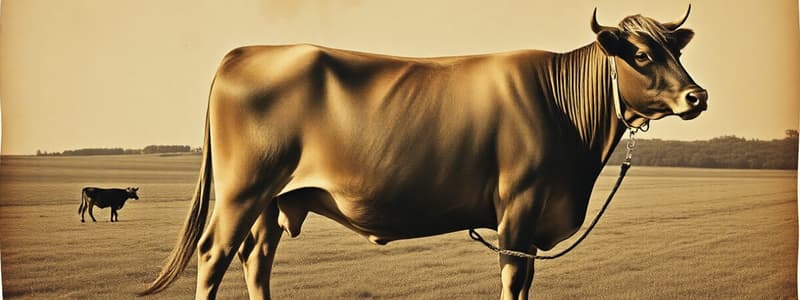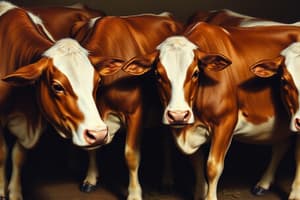Podcast
Questions and Answers
What is the finishing phase in cattle production?
What is the finishing phase in cattle production?
- The time when cattle are raised on grass only
- The final feeding stage before reaching market weight (correct)
- The stage where cattle are bred for reproduction
- The period after giving birth to the first calf
At what age do cattle typically reach market weight?
At what age do cattle typically reach market weight?
- 18-22 months (correct)
- 12-15 months
- 24-30 months
- 30-36 months
What is the weight range for cattle when they reach market weight?
What is the weight range for cattle when they reach market weight?
- 1400 to 1600 lbs
- 1000 to 1200 lbs
- 800 to 1000 lbs
- 1200 to 1400 lbs (correct)
What distinguishes grass-fed beef from feedlot beef?
What distinguishes grass-fed beef from feedlot beef?
What is a first-calf heifer?
What is a first-calf heifer?
Which term refers to female cattle that are not currently producing milk?
Which term refers to female cattle that are not currently producing milk?
What characterizes purebred cattle?
What characterizes purebred cattle?
What is the purpose of a seedstock operation?
What is the purpose of a seedstock operation?
What term is used to describe a castrated male bovine?
What term is used to describe a castrated male bovine?
Which of the following describes the primary diet of stockers before entering a feedlot?
Which of the following describes the primary diet of stockers before entering a feedlot?
At what age are stocker cattle typically sent to a feedlot?
At what age are stocker cattle typically sent to a feedlot?
Which of the following breeds is known for being polled?
Which of the following breeds is known for being polled?
What is the primary distinction between suckling calves and veal calves?
What is the primary distinction between suckling calves and veal calves?
What color is most commonly associated with the Charolais breed?
What color is most commonly associated with the Charolais breed?
What is the typical weaning age for most beef calves?
What is the typical weaning age for most beef calves?
Which beef production system is characterized by breeding programs for genetic improvement?
Which beef production system is characterized by breeding programs for genetic improvement?
Which factor is crucial for the profitability of cow-calf and stocker operations?
Which factor is crucial for the profitability of cow-calf and stocker operations?
What is the typical daily weight gain for cattle on a high energy diet in finishing operations?
What is the typical daily weight gain for cattle on a high energy diet in finishing operations?
What commonly used identification method is employed for individual cows?
What commonly used identification method is employed for individual cows?
Which of the following is NOT a common reason for culling cattle from a herd?
Which of the following is NOT a common reason for culling cattle from a herd?
In feedlot operations, how are cattle typically fed?
In feedlot operations, how are cattle typically fed?
What is the primary goal of a cow-calf operation?
What is the primary goal of a cow-calf operation?
Which term describes the operation where younger calves are raised while grazing on inexpensive feed sources?
Which term describes the operation where younger calves are raised while grazing on inexpensive feed sources?
What defines fed cattle?
What defines fed cattle?
What is culling in the context of cattle management?
What is culling in the context of cattle management?
What specific age range applies to a calf in cattle terminology?
What specific age range applies to a calf in cattle terminology?
What is a characteristic of a feedlot (or finishing) operation?
What is a characteristic of a feedlot (or finishing) operation?
What does the term 'feeders' refer to in cattle terminology?
What does the term 'feeders' refer to in cattle terminology?
What is the key feature of a bull in cattle production?
What is the key feature of a bull in cattle production?
What is the primary goal of a cow-calf operation?
What is the primary goal of a cow-calf operation?
At what age are female calves typically bred for the first time?
At what age are female calves typically bred for the first time?
What is the typical weight range for calves at birth?
What is the typical weight range for calves at birth?
What is the main purpose of the feedlot operation?
What is the main purpose of the feedlot operation?
How long do feeder cattle typically stay in a feedlot?
How long do feeder cattle typically stay in a feedlot?
What is a key characteristic of beef cattle's digestive system?
What is a key characteristic of beef cattle's digestive system?
What happens to steer calves and heifers not kept for breeding?
What happens to steer calves and heifers not kept for breeding?
What is the weight range of cattle at market readiness in the feedlot?
What is the weight range of cattle at market readiness in the feedlot?
Flashcards are hidden until you start studying
Study Notes
Cattle Terminology
- Backgrounder operation involves raising weaned steer and heifer calves to 12-16 months while grazing inexpensive feeds, developing lean muscle before entering feedlots.
- Bulls are sexually mature male bovines used for breeding, while beef cattle are specifically raised for meat production.
- A cow-calf operation aims to produce one calf per cow annually, typically with a gestation period of about nine months, from birth to weaning at 6-10 months.
- Culling refers to removing animals from a herd for health or production issues, ensuring herd efficiency.
- Feedlot operations confine beef cattle on high-energy diets, lasting 90-180 days, to reach market weight (1,200-1,400 lbs) at 18-22 months of age.
- Finishing period denotes the final feeding stage before cattle reach market weight.
- Grass-fed beef comes from cattle raised mainly on pasture rather than concentrated feed, emphasizing a natural grazing system.
Beef Cattle Breeds
- Angus is popular, hornless, adaptable, and comes in black and red varieties.
- Brahman, known for heat tolerance and insect resistance, is a zebu breed imported from India.
- Charolais is a white French breed known for its size and meat quality.
- Hereford features a red coat with a white face, originating from southern England, and has horned and polled varieties.
- Limousin is another French breed recognized for its lean meat.
- Santa Gertrudis, developed in Texas, comes from breeding Brahman bulls with Beef Shorthorn cows, thriving in harsh climates.
Production System and Life Cycle
- The four types of beef production systems are cow-calf, backgrounder, feedlot, and seedstock.
- Cow-calf operations typically produce calves for breeding or meat, requiring each cow to raise one calf annually.
- Backgrounder operations take calves at 6-12 months, providing forage until they reach 12-16 months before entering feedlots.
- Feedlot operations finalize cattle growth through high-energy diets, creating market-ready animals within a defined finishing period.
- Seedstock operations focus on producing purebred cattle for genetic improvements in specific breeds.
Feeding
- Beef cattle are ruminants with multi-compartment stomachs that digest fibrous plants through symbiotic bacteria.
- Profitability in cow-calf and stocker operations depends on affordable feed, primarily grasslands.
- Finishing diets in feedlots consist of high-energy cereal grains, promoting growth rates of 2.5-4 pounds per day.
- Cattle in feedlots are fed twice daily with constant access to water through troughs or automatic systems.
Housing
- Cattle on cow-calf and stocker operations are primarily raised outdoors, receiving shelter during bad weather.
- Feedlots confine cattle to maximize feed intake, with pens often having dirt floors and provided bedding.
Identification
- Animal identification is crucial for traceability in disease management, with plastic ear tags being the most common method.
- Alternative identification methods include Brucellosis tags, hot-iron branding, ear tattooing, and electronic IDs or microchips.
Culling
- Reasons for culling include health issues, production problems, infertility, or economic factors that necessitate herd reduction or market adaptation.
Studying That Suits You
Use AI to generate personalized quizzes and flashcards to suit your learning preferences.




